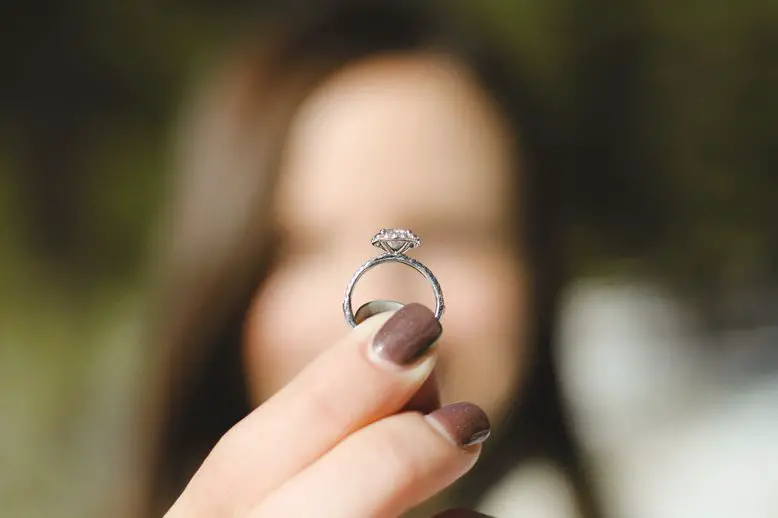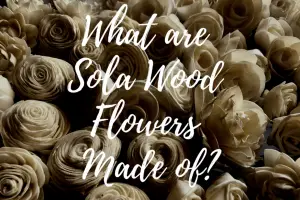In the search to find ways of reducing waste at our weddings, many of us are also looking at ways to ensure that our wedding/engagement rings and bands are also eco-friendly. Let’s start with the question: What is an eco-friendly wedding ring or wedding band?
An eco-friendly wedding ring is one that is created in such a way that it doesn’t harm the environment. The most eco-friendly wedding ring you can wear is one that is recycled or vintage. But if your heart’s set on a diamond, a lab grown diamond may be ecologically preferable to a mined diamond.
I’m certainly not perfect in my pursuit of eco-friendly rings, but I’ve done a lot of research and I’m going to share everything I’ve learned with you here.
In this eco-friendly wedding ring guide, I’ll talk about:
- The most eco-friendly wedding ring choice you can make
- Why a lab-created diamond, although not exactly eco-friendly, is preferable to a mined diamond
- Wedding ring metals and the environmental impact
- Silicone wedding rings: What are they and are they eco-friendly?
- My recommendations for eco-friendly wedding ring companies
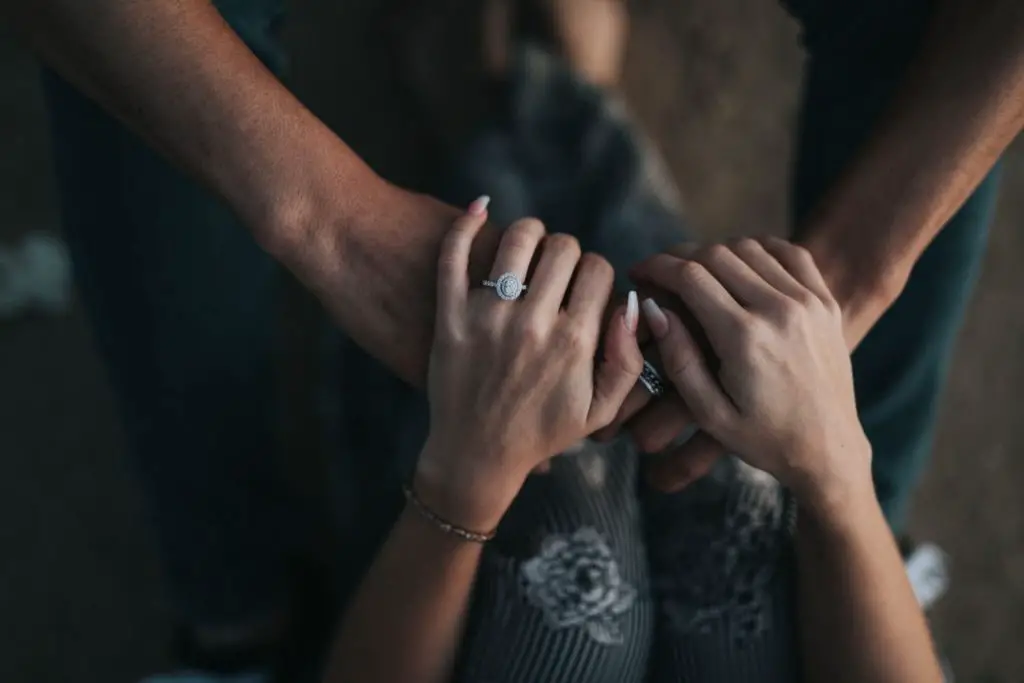
Basically, if it’s an eco-friendly ring you want, this guide will weight the pros and cons of the options out there and help you decide. I’ve even included some eco-friendly and/or ethical companies for you to check out at the bottom of this post.
Wedding/engagement ring-buying isn’t the simplest of decisions to make, as there isn’t a whole lot of transparency among much of the jewelry industry (especially the diamond industry) when it comes to where they are sourcing their materials from, and how the environment and workers are being impacted. I’ve done some research to help clarify things.
I strongly suggest you also check out my post on the eco-friendliness of diamonds, which breaks down in detail many of the ecological and ethical factors of deciding between a lab-created diamond and a mined diamond.
NOTE ON WEDDING RING VS. ENGAGEMENT RING: I use these two terms interchangeably in this post! Technically your ‘engagement ring’ is the diamond ring given to one partner to wear during the engagement period, and the ‘wedding rings’ are exchanged during the wedding ceremony (added on to the engagement ring), but I am referring to all of the above in this post!
The Most Eco-Friendly Choice You Can Make: “Used” Wedding Rings
The most eco-friendly choice you could possibly make in terms of wedding and engagement rings is to buy one secondhand, or buy a vintage or antique ring. A wedding ring that has been worn in the past isn’t further wounding the Earth, and doesn’t require yet more energy to create. It’s already been made and so we should reuse it if we can.
A ‘used’ ring can also be really special if it belonged to someone in your family or a friend. Some friends of mine have taken rings that belonged to their family members and reset them into a different ring, so part of it was recycled, and so that the sizing and style of the ring better matched the new owner. With that in mind, you might be able to even turn an old necklace or bracelet into a beautiful wedding ring.
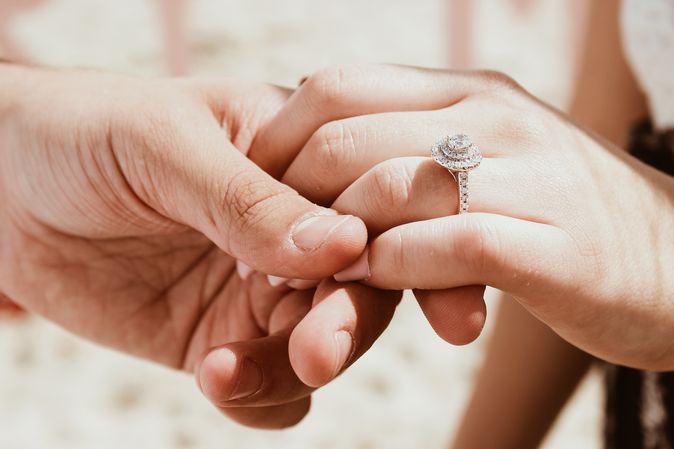
If you don’t have the option of inheriting a piece of jewelry, there are plenty of places where you might find a secondhand ring, including thrift shops, antique shops, and estate sales. You may even want to check out unconventional jewelry shopping avenues, such as the Facebook marketplace.
Made Trade is an awesome, ethical platform to find hand-made artisan jewelry pieces (as well as fair trade dresses, shoes, and any other thing you can think of).
One thing to be careful of when shopping secondhand shops: I wouldn’t buy an expensive piece of jewelry without first certifying that it’s legitimate. If you’re buying a diamond ring, for example, ensure that the ring has a certificate of authenticity from the American Gem Society, or ask if you can have it appraised before buying it.
Are they Eco-Friendly? Lab-Grown Diamonds vs. Mined Diamonds
What if you don’t want a secondhand ring? What if you really want the traditional diamond wedding ring and you want it to be your own? What eco-friendly choices do you have?
You have two options for real diamonds, both of which are absolutely identical chemically and physically: “lab-created” or “lab grown” diamonds which are created in a matter of weeks or months in a factory; and “mined diamonds” which take 1-3 billion years to make and must be mined from the Earth.
Which is more eco-friendly? Which is more ethical? Sustainable?
The bottom line with this debate is: this There is no easy choice. Lab-created diamonds are not eco-friendly, as they require quite a lot of non-renewable energy to make. Mined diamonds aren’t eco-friendly either, leaving huge gaping open pits in the ground and wrecking natural ecosystems.
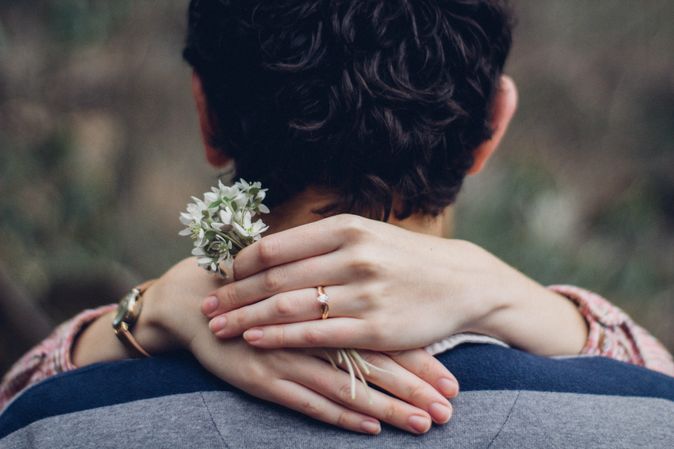
Scientific research suggests we still have more work to do to find out if lab grown diamonds are a sustainable replacement for mined diamonds. However, there is a strong case to be made that, when compared to diamonds that are mined, lab diamonds are the better choice.
As I mentioned earlier, I’ve written a really in-depth look at lab-grown versus mined diamonds (complete with a simplified comparison chart of the two based on hours of research!) and I suggest you check it out if this is a question that’s been on your mind as much as it’s been on mine.
There has been so much debate (mostly between diamond companies) over the eco-friendliness of lab-grown diamonds. Consumers are becoming more and more aware of the destruction of the mining industry and appalled at the inhumane practices that some of the diamond miners and polishers have had to endure.
There’s no doubt that mining is disastrous for the environment, that diamond mining uses enormous amounts of water and harms ecosystems around the world by digging huge open pits.
Ethically, mining diamonds is also questionable, with a long history of “conflict diamonds” — despite systems but in place to fix these problems such as the Kimberly Process to reduce the flow of conflict diamonds. It’s still not 100% effective.
On the other hand, many diamond workers around the world rely on the diamond industry. As consumers, we’re in a tough spot of deciding whether to support an industry that isn’t sustainable for the environment, or not buying a product that keeps millions of people employed.
Though it is no easy choice, if you do decide to support lab-created diamonds (which are conflict-free, if not completely eco-friendly), you can find beautiful and affordable lab-created diamond rings at Clean Origin, a company specializing in ethical REAL diamonds.
Wedding Rings Metals & Environmental Impacts
Other metal industries, such as the gold, palladium, platinum, and silver industry, are major polluters to the environment as well. We have to consider the environmental impact of the metals we’re buying for our wedding rings, as well as the stones.
“There is no such thing as clean gold, unless it’s recycled or vintage”
-Alan Septoff, Communications Manager for the No Dirty Gold campaign
According to Smithsonian Magazine, “The majority of the world’s gold is extracted from open pit mines, where huge volumes of earth are scoured away and processed for trace elements.”
In order to make one 1/3 ounce 18-karat gold ring, we produce at least 20 tons of waste and 13 pounds of toxic emissions, including 5 and a half pounds of lead, 3 pounds of arsenic, almost 2 ounces of mercury, and 1 ounce of cyanide (Source). That is insane! And honestly, makes me look down at the gold rings I’m wearing with more than a little guilt.
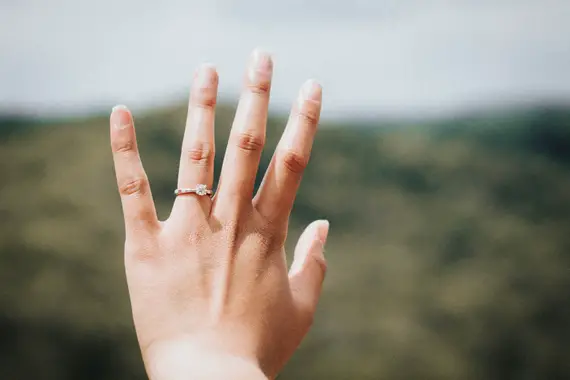
Some have said that metals such as tungsten and titanium are more eco-friendly choices, however that depends on the mine. Some mines don’t have eco-friendly extraction processes or regulations, which means that we really need to dig and ask questions about the sources these jewelry companies are using.
If we want to be truly eco-friendly, we have a couple of choices. We can either melt down old jewelry to create a recycled wedding ring; or we can buy our wedding rings from companies that use recycled metals in the creation of their rings. Noemie is one such company that uses 18-karat reclaimed gold (made from existing jewelry) in their products.
Silicone Wedding Rings: Eco-Friendly?
Have you heard of silicone wedding rings? More and more couples are opting to buy silicone rings instead of wedding rings made out of metal. Much of the reason for this is because they’re easier to exercise in!
Here’s what they look like: Men’s silicone rings and women’s silicone rings. They come in a TON of different colors and the idea is that you can switch them out daily if you wanted to match your outfit.
Many couples also find them more comfortable than metal rings, and they’re safer if you do a lot of work with your hands. Silicone rings can be easily removed in an emergency and their flexibility makes life a lot easier if you’re in certain lines of work.
But are they eco-friendly?
After searching around a bunch to find the answer to this, I came to the conclusion that silicone rings are eco-friendly in the way that lab-grown diamonds are eco-friendly.
What I mean is that we’re creating more products (lab diamonds, silicone rings, etc.) to fit a need that we’ve all created as a society, in order to replace worse-for-the-environment options (mined diamonds, mined metals)…
….WHEN REALLY, if we’re being honest with ourselves, the best thing for the environment would be to not make any of these products at all! And just recycle material that we already have to make our rings.
But since we always want new stuff, even though I wouldn’t exactly call silicone rings eco-friendly, they do serve a purpose for many people and I totally see the appeal.
Recommendations for Eco-Friendly Wedding Rings
I’ve been thinking about this post for a while and compiling the most ethically-sourced and eco-friendly engagement (and wedding) ring options I have come across over the past several months.
No option is perfect. Every option will have its drawbacks. But awareness is key. We’re taking a big step even in asking the question: Is this eco-friendly? Is this ethical? Many people don’t even think to think about where their jewelry is coming from.
Most of us don’t, in fact. It’s not always easy to ask these questions, and it’s not easy to find companies who are being transparent… and who are making eco-friendly and ethical choices in their supply chains.
Here are some companies that I would recommend for eco-friendly and/or conflict-free jewelry:
Made Trade
Mentioned earlier in this post, I really love Made Trade and its philosophy. They source artisan products from around the world, supporting women and insisting on fair trade.
Anything you purchase from Made Trade you know is going to support a good cause, and you’ll be getting quality in return. They sell rings, but SO MUCH MORE as well.
Clean Origin
For ethical, lab-grown diamonds, visit Clean Origin‘s diamond collection, and also notice that lab diamonds are much, much cheaper than mined diamonds! Sometimes a third or a fourth of the price!
There’s no real reason for this price difference except that the industry has artificially created it. Why would anyone pay an artificially inflated price for a diamond that is chemically and physically the same but was just created differently? I don’t know. It blows my mind.
Another cool thing: On Clean Origin, you can actually select the size, shape, color, cut, and other specific dimensions of the diamond and ring that you want.
Noémie
This is a jeweler that, as previously mentioned, uses reclaimed 18-karat gold, as well as conflict-free lab-created diamonds. They allow customers to personalize their rings to make them “one-of-a-kind.”
Joie de Viv
Joie de Viv is a jewelry retailer that uses 100% lab-created real diamonds. They boast that their diamonds are all traceable and made in the USA.
FOR MEN
Men, I didn’t forget about you!
Men’s Ceramic and Wood Ring – Wedding rings made out of eco-friendly ceramic and wood, such as this one found on Amazon, may be a good fit for a lot of men.
Instead of hard, mined metals that are detrimental to the environment and potentially unsafe for your finger if you lead a very active lifestyle, consider something like this.
Why Should We Care About Eco-Friendly Wedding Rings?
My concern comes from a trend I’ve noticed of near total apathy about knowing the origins of one’s jewelry and diamonds. I’m sad for the lack of care many of us as consumers display for the sourcing of our engagement and wedding rings.
I know it’s impossible to be perfect all the time, and to always make the most ethical or eco-friendly decisions on a day-to-day basis. However, on an occasion such as a wedding, which is supposed to be representative of love… and especially with the purchase of a ring that you will look at your entire life and that will represent your love, should we not strive to make sure that this piece of jewelry did not cause pain and suffering to other human beings and the planet before we paid thousands of dollars for it?
We turn a blind eye constantly to the questionable origins of our clothes, phones, and other consumer goods, which is bad enough; but somehow I’m especially saddened at the hypocrisy of an unethically-sourced diamond representing a beautiful love story.
This is all pretty long-winded and imperfect. I don’t claim to have the perfect argument. I just know that many diamond and jewelry companies are doing this wrong, are hurting people, and are overcharging us for it. So this is as much a cry out to myself as well as to other: Let’s try to be better.

